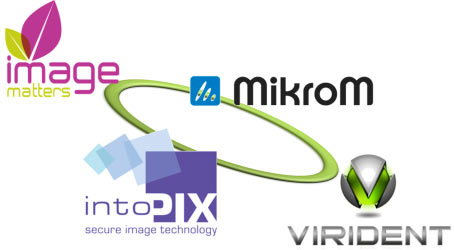Your analogy Michael, of going from standard definition to high definition or from VHS to DVD is a good one, but it doesn’t inform one of how it is similar. It is not that there are more pixels, it is that more pixels are able to be a discernible part of the picture…or can be if the director chooses. Another analogy would be to say that there is more depth of field, but instead of talking about the amount of available focus behind the point of focus, we get more ability to focus in front of the point of focus. Normally all that area in front is not only out of focus, but during any kind of motion in the scene or the camera, there is a smearing that contributes to destroying contrast in the picture. It is also very tiring for the eyes.
Cameron’s demonstration a year ago at CinemaCon made use of sword fighting and sweeping the camera around a fairly large room. The most vivid shot that allowed the technology to prove itself was a long, medium speed pan of several actors and actresses sitting at a long table with food and candles in front of them. There was also another set of actors whose backs were to us, so we’d see the back of their heads, with the view of the candles going in and out. At 24 frames per second (fps) the scene was typical, in-focus faces and quasi-focused candle flames with smeared blurs of the actors backs in front. At 48 frames per second, the smearing left. It wasn’t so important that the backs of these heads and shoulders were in focus, but that the smearing was gone so the discernible luminance of the scene increased – loosely, more contrast means colors and more colors means more natural feeling. The candle flames were brighter without being any more in focus.
Now I will bring 3D into the conversation and tell you that you are wrong Michael. 3D is not just a gimmick, and not just another tool. In fact, each picture that we see has dozens of clues of dimensionality without the parallax clues that stereoscopy brings. Everything from colors fading as we see them in the distance, to a fuzziness at the intersection of two objects (notice the shoulders compared to their background) to comparative sizes and not seeing a person’s legs when a table is in front of them, all tell the human visual system of eyes and brain and mind that there is a third dimension in the scene we are looking at. On the other hand, my guess is that most technical people in the business generally dislike the current implementations of Stereoscopic 3D, but for reasons that don’t have to do with the ugliness of the glasses or the upcharge or whether a well written scene could have served just as well. Most dislike it because even with the inherent horrors of the combination of high gain and silver screens (each with their own set of insurmountable problems), there isn’t enough light to do the process justice. And again, less light means more in-the-mud colors and fewer colors overall, especially whites and the light subtle colors that we normally use to discern subtle things.
I also was not a fan of S-3D until I saw the ‘dimensionalization’ of the final scene of Casablanca. I thought it was marvelous. It was on the other side of compelling. It was as if there needed to be an excuse to leave out the parallax. That doesn’t make badly shot or poorly dimensionalized S-3D OK, but it does make any S-3D ‘Not Ready for Prime Time’ when it isn’t then presented correctly – and that mostly has to do with the amount of light from the screen to the eyes. Which brings us back to High Frame Rates.
There was a two day set of SMPTE seminars dealing with digital cinema before NAB, which was the week before CinemaCon. Several thousand engineers got full geek treatment with an hour of ‘why lasers in the projector’ then seeing 6 minutes of demonstrations of Sony projectors with retrofit Laser Light Engines, Inc.’ laser systems, and 40 minutes on the various problems that high frame rates bring to the post production workflow, then 20 minutes of presentation from a technical representative from Peter Jackson’s team who explained some technical considerations of HFR.
There is a commonly held misconception that 24 frames per second was chosen because testing determined that this speed had something to do with the natural flutter rate of the eyes. In fact, 24 fps was chosen because it brought a movies sound to the point where it was not horrible. Similarly, there is some magic above 50 something fps and as we also learned (while Sperling was at Coachella missing the SMPTE event), there are potential problems to be wary of at 48 frames per second, demonstrated by Dr. Marty Banks of Cal Berkeley. So…
To answer one of your questions Michael, 48 frames was chosen at the time because they weren’t certain if equipment manufacturers would be able to get a working high frame rate system available by the time that The Hobbit was going to be released. But anyone who reads the trades most certainly knows that frame rates up to 60 have been in the specifications and doable since Series II projectors became available from Texas Instruments. Ah! but not in S-3D. As Sperling pointed out, this requires “in the projector” electronics to be fitted (or retrofitted) and a whole new way of thinking servers for the projector. An example: Sony announced to their 13,000 customers – give us $3,000 and we will retrofit your software to do S3D-HFR.
Going back though, to the demonstrations that Cameron did a year ago. In addition to 48fps S3D – which got rid of the front of focus blur – there were also identical shots taken at 60fps S3D. They were less WOW! but still importantly beneficial. Because of time constraints and the fact that we were sitting among Cameron’s other several thousand friends in the auditorium, there wasn’t a lot of time to look at these shots, but they reminded me of the arguments that George Massenburg made in a famous 3 part article entitled Lace and Filigree, written during audio’s transition to digital in the mid-80’s. There is something special as the speed improves akin to the benefits of increasing signal to noise in its various forms. Perhaps it all serves to put technology into the sphere of philosophy where it belongs. It certainly reminds us that all technology involves the art of compromise.
Last short aside, during the SMPTE event with the HFR panelists still on stage. One engineer came to the open mic and made a statement about government S3D skunkwork experiments that he had been part of which indicated that there was something that ‘popped’ at 53 fps and wondered if anyone else had run into that phenomena. The chair answered with a few speculations then expressed regret that Douglas Trumbull wasn’t there to give insights to his experiments in the field, since he not only had the longest record of making high frame rate movies but just opened a new digital high frame rate studio that has made several technical break-thoughs. And just like the Annie Hall/Marshall McLuhan moment, Doug came to the mic and added a few quips… OK; so that’s all we geeks get for high-level entertainment.
Keep up the good work. I enjoy the show and don’t begrudge any extra minutes you take to get all the interesting news of the week to us.
[Author’s salutations]
References:
High Frame Rates – The New Black, Getting to Speed
Combine 3, Drop 2, 120 becomes 24



